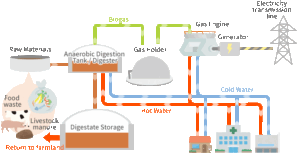

What is meant by a pure substance?
A pure substance is defined as a material with a uniform chemical composition throughout. Examples of pure substances include water, nitrogen, helium, and carbon dioxide.
It is important to note that a pure substance does not necessarily consist of a single chemical element or compound. A mixture of different chemical elements or compounds may also be classified as a pure substance, provided that the mixture is homogeneous.
For instance, air, although composed of several gases, is often considered a pure substance due to its consistent chemical composition. Conversely, a mixture of oil and water does not meet the criteria for a pure substance. This is because oil is insoluble in water, leading to the formation of two distinct chemical phases.
What are the phases of Pure substance?
Pure substances exist in three principal phases: solid, liquid, and gas. Within each of these phases, a substance can exhibit multiple forms, each characterized by a distinct molecular structure. For instance, carbon can take the form of either graphite or diamond in its solid state. Helium can exist in two distinct liquid phases, while iron has three separate solid phases.

A phase is characterized by a uniform molecular arrangement throughout, which is distinctly separated from other phases by clear boundary surfaces. The coexistence of solid ice and liquid water provides a clear example of this concept. Under high pressures, ice can manifest in seven different phases. It can be seen that the Intermolecular bonds are strongest in solids, resulting in closely packed molecules, whereas, in gases, these bonds are weakest, leading to molecules being spread apart by relatively large distances.
In a solid, the molecules are arranged in a repetitive three-dimensional lattice structure. Due to the minimal distance between molecules, strong attractive forces hold them in fixed positions. It is important to note that as the distance between molecules approaches zero, these attractive forces shift to become repulsive, preventing the molecules from collapsing into one another. Although the molecules in a solid cannot move freely, they continuously oscillate around their equilibrium positions. The speed of these oscillations is temperature-dependent. At sufficiently high temperatures, the increased velocity and momentum of the molecules can partially overcome the intermolecular forces, causing groups of molecules to break away, marking the onset of the melting process.
The spacing between molecules in the liquid phase is quite similar to that in the solid phase, but the key difference is that the molecules in a liquid are no longer fixed in place. Instead, they can move and rotate freely. While the intermolecular forces in liquids are weaker than those in solids, they remain significantly stronger than in gases. When a solid transitions into a liquid, the distance between molecules usually increases slightly, though water is a notable exception to this general trend.
In the gas phase, molecules are widely spaced and lack any organized structure. They move randomly, frequently colliding with one another and with the walls of their container. At low densities, intermolecular forces are minimal, making collisions the primary form of interaction between molecules. Gas molecules possess significantly higher energy compared to their counterparts in the liquid or solid phases. As a result, a gas must release a substantial amount of energy before it can condense into a liquid or solidify.
Terminology Related to the Phase Change Processes of Pure Substances
Compressed Liquid & Saturated Liquid
Consider a piston-cylinder device containing liquid water at 20°C and a pressure of 1 atm(State 1). Under these conditions, the water remains in the liquid phase and is referred to as a compressed or subcooled liquid, meaning it is not close to vaporizing.
As heat is transferred to the water, its temperature rises to around 40°C. With the increase in temperature, the liquid water slightly expands, causing a small increase in its specific volume. To accommodate this expansion, the piston moves upward slightly. Throughout this process, the pressure within the cylinder remains constant at 1 atm, as it is determined by the external barometric pressure and the weight of the piston, both of which remain unchanged. The water is still considered a compressed liquid since it has not begun to vaporize.
As additional heat is transferred, the temperature continues to rise until it reaches 100°C(State 2). At this stage, the water remains in the liquid state, but any further heat addition will initiate vaporization. In other words, the water is on the verge of undergoing a phase change from liquid to vapor. A liquid that is about to vaporize is called a saturated liquid, making this state a saturated liquid state(State 2).

water at constant pressure.
Saturated Vapor & Superheated Vapor
Once boiling begins, the temperature remains constant until the liquid is fully vaporized, provided the pressure is maintained. During this phase change, the temperature does not increase; instead, the volume of the substance expands significantly, and the liquid level steadily decreases as more of the liquid turns into vapor.
At the midpoint of the vaporization process (state 3), the cylinder contains equal amounts of liquid and vapor. As heat continues to be transferred, the vaporization process progresses until all the liquid is converted into vapor (state 4). At this point, the cylinder is filled entirely with vapor that is on the verge of condensing back into a liquid if heat is removed. This vapor is called a saturated vapor, making state 4 a saturated vapor state. The substance in states between 2 and 4 is referred to as a saturated liquid-vapor mixture, where the liquid and vapor phases coexist in equilibrium.
Once the phase change is complete, the system returns to a single-phase region, now consisting entirely of vapor. Further heat transfer leads to an increase in both temperature and specific volume .
At state 5, the vapor temperature is, for example, 300°C. If heat is removed from this vapor, its temperature may decrease slightly, but as long as it remains above 100°C (at a pressure of 1 atm), no condensation will occur. A vapor that is not on the verge of condensing is referred to as a superheated vapor. Thus, at state 5, the water exists as a superheated vapor.
This constant-pressure phase-change process is depicted on a T-v diagram. If the entire process is reversed by cooling the water while maintaining the same pressure, the water will return to state 1, retracing the same path. In doing so, the amount of heat released during cooling will exactly equal the amount of heat added during the heating process.
What is meant by Saturation Temperature and Saturation Pressure?
It is well known that water boils at 100°C when the pressure is maintained at 1 atm (101.325 kPa). This boiling point is determined by the constant pressure of 1 atm. If the pressure inside the cylinder is increased to 500 kPa by adding weights on the piston, water will begin to boil at a higher temperature of 151.8°C.
This indicates that the boiling temperature of water is dependent on the pressure; thus, when the pressure is fixed, the boiling temperature is also fixed.
The temperature at which a pure substance undergoes a phase change at a specific pressure is referred to as the saturation temperature (Tsat). Conversely, the pressure at which a pure substance changes phase at a given temperature is known as the saturation pressure (Psat).
Example : At a pressure of 101.325 kPa, the saturation temperature (Tsat) is 99.97°C. Conversely, at a temperature of 99.97°C, the saturation pressure (Psat) is 101.325 kPa.

What is Latent Heat?
Latent heat refers to the significant amount of energy required to either melt a solid or vaporize a liquid. This energy, absorbed or released during a phase change, is known as latent heat. Specifically, the energy absorbed during the melting process is termed the latent heat of fusion, which is equal to the energy released during the freezing process.
Similarly, the energy absorbed during vaporization is referred to as the latent heat of vaporization, which corresponds to the energy released during condensation. The values of latent heats vary based on the temperature and pressure at which the phase change occurs. For instance, at a pressure of 1 atm, the latent heat of fusion for water is 333.7 kJ/kg, while the latent heat of vaporization is 2256.5 kJ/kg.
Liquid-vapor saturation curve

During a phase-change process, pressure and temperature are interdependent properties, with a specific relationship between them expressed as Psat = f(Tsat). A graph depicting Psat against Tsat, like the one for water, is referred to as a liquid-vapor saturation curve, which is characteristic of all pure substances.
It is evident that Tsat increases as Psat increases; hence, a substance will boil at higher temperatures under higher pressures.
As altitude increases, atmospheric pressure—and consequently the boiling temperature of water—decreases. This means that cooking takes longer at higher elevations compared to sea level, unless a pressure cooker is utilized. For instance, at an elevation of 2000 m, the standard atmospheric pressure is 79.50 kPa, which corresponds to a boiling temperature of 93.3°C, compared to 100°C at sea level (zero elevation).
References
Cengel, Y.A. and Boles, M.A. (2006) Thermodynamics: An Engineering Approach. Fifth Edition, McGraw Hill, New York.


